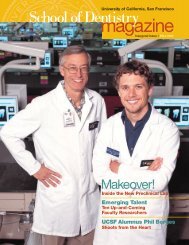Acknowledgements - UCSF School of Dentistry - University of ...
Acknowledgements - UCSF School of Dentistry - University of ...
Acknowledgements - UCSF School of Dentistry - University of ...
You also want an ePaper? Increase the reach of your titles
YUMPU automatically turns print PDFs into web optimized ePapers that Google loves.
#43 Title: The Function <strong>of</strong> Leucine Rich Amelogenin Peptide (LRAP) in tooth formation.<br />
J STAHL, Y NAKANO, T LE, P DEN BESTEN<br />
<strong>UCSF</strong> Department <strong>of</strong> Or<strong>of</strong>acial Sciences<br />
Background: LRAP, or leucine rich amelogenin peptide (LRAP) is a 59 amino acid alternatively spliced amelogenin, which includes<br />
the first 33 and the last 26 amino acids from the full-length amelogenin. LRAP has been shown to have cell signaling properties,<br />
though its function in enamel formation remains unknown.<br />
Objective: To determine the effects <strong>of</strong> LRAP in mouse tooth formation, using a transgenic mouse, which overexpresses LRAP.<br />
Methods: Hemi-maxillas <strong>of</strong> wild-type (WT), and LRAP overexpressor in wild-type background (LRAP/WT) mice (0 and 5 days postnatal)<br />
were fixed in 4% paraformaldehyde, and demineralized in 8% EDTA (Ph 7.6) AT 4˚C. The jaws were embedded in paraffin for<br />
longitudinal sectioning. The localization <strong>of</strong> various matrix, differentiation, and signaling proteins in the developing tooth organ were<br />
compared by immunohistochemistry (IHC). Immunoreactivity was detected with a Vecastatin ABC kit. Right dry hemimandibles<br />
were scanned with a microCT to characterize the mineral density <strong>of</strong> the dental tissues in WT and transgenic mice.<br />
Results: In both newborn and day 5 mice, ameloblast morphology was disrupted, suggesting an interference with cell polarization.<br />
IHC In newborn LRAP/WT mice revealed a transient upregulation <strong>of</strong> amelogenin in secretory ameloblasts and adjacent<br />
odontoblasts, with no similar upregulation in WT mouse molars. In the maxillary first molar <strong>of</strong> postnatal day 5 LRAP/WT mice,<br />
ameloblasts were poorly organized and enamel matrix formation was almost completely absent. Amelogenin immunostaining in the<br />
cell cytoplasm <strong>of</strong> LRAP/WT mice was increased as compared to controls, and Lamp1 was upregulated in both ameloblasts and<br />
odontoblasts <strong>of</strong> postnatal day 5 LRAP/WT mice. Initial microCT data showed an overall delay in mandibular incisor and molar<br />
development in the LRAP/WT mice at the early post-natal stage.<br />
Conclusions: Early overexpression <strong>of</strong> LRAP interferes with ameloblast function and tooth development.<br />
# 44 Title: Are Dental Caries in Adolescents Associated with Health Insurance?<br />
S SUNDARRAJAN (1), J CHENG (2), S HYDE (2)<br />
(1) Graduate Division <strong>UCSF</strong>, (2) <strong>UCSF</strong> Department <strong>of</strong> Preventive and Restorative Dental Sciences<br />
Objective: To determine the association between health insurance and dental caries among adolescents aged 12-19 years from a<br />
national sample <strong>of</strong> a diverse population.<br />
Methods: This secondary data analysis <strong>of</strong> the continuous National Health and Nutrition Examination Survey (NHANES) data set<br />
from 2005-2008 focuses on the oral health exam component, health insurance, and demographic variables. The primary outcome<br />
measure is the presence <strong>of</strong> dental caries, and the predictor <strong>of</strong> interest is health insurance. Covariates in the analyses include age,<br />
gender, race/ethnicity, country <strong>of</strong> birth, annual family income, and presence <strong>of</strong> dental sealant. Data were analyzed using STATA 11.<br />
Since NHANES was a multistage, complex survey, Stata’s survey commands and pweight option were used to handle the sampling<br />
weights and clustering.<br />
Results: Teenagers without dental sealants, born outside the US, who were Mexican American, Other Hispanic, or Non-Hispanic<br />
Black, and whose families did not have health insurance had twice the number <strong>of</strong> decayed teeth as those with sealants, born in the<br />
US, Non-Hispanic Whites, and whose families did have health insurance (all p




